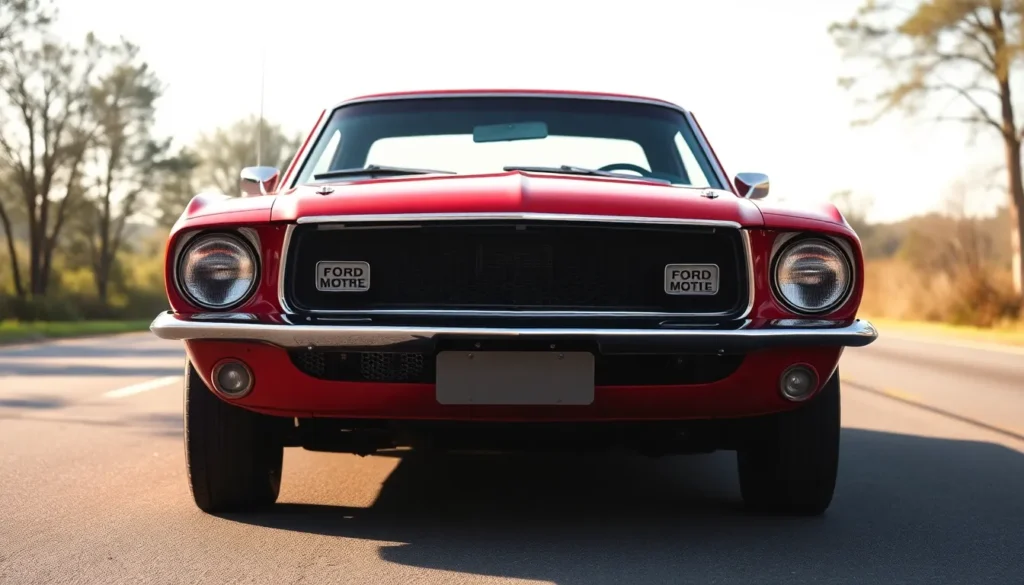The 1969 Ford Mustang stands as one of the most iconic muscle cars ever built – a true masterpiece that defined an entire generation of American automotive excellence. We’re talking about the year Ford completely redesigned their pony car legend creating what many consider the most desirable Mustang ever produced.
This wasn’t just another model year update. The ’69 Mustang represented Ford’s bold response to growing competition from Chevrolet’s Camaro and Pontiac’s Firebird. With its aggressive new styling longer hood and wider stance the 1969 Mustang looked ready to devour any road it touched.
We’ll explore what made this particular year so special from the legendary Boss 302 and Mach 1 variants to the subtle design changes that transformed the Mustang’s entire personality. Whether you’re a classic car enthusiast or simply curious about automotive history the 1969 Mustang’s story reveals why this machine continues to captivate collectors and dreamers alike more than five decades later.
The Legend of the 1969 Ford Mustang
The 1969 Ford Mustang emerged as a complete transformation from its predecessor, marking the most important redesign in the model’s five-year history. Ford engineers stretched the wheelbase by 1 inch to 108 inches and extended the overall length by 3.8 inches, creating a more aggressive stance that commanded attention on every street corner.
Performance enthusiasts witnessed the birth of two legendary variants that year: the Boss 302 and Mach 1. Boss 302 models featured a high-revving 302 cubic inch V8 engine producing 290 horsepower, specifically engineered for Trans Am racing competition. Mach 1 variants offered multiple engine options, including the powerful 428 Cobra Jet V8 that delivered 335 horsepower and transformed the Mustang into a legitimate muscle car contender.
Visual updates defined the 1969 model year with four distinctive headlights replacing the previous dual headlight design. Designers implemented a more muscular hood with simulated air scoops, while the rear fascia received quad taillights that became an instant classic styling element. Chrome bumpers wrapped around the front end, complemented by a horizontal grille pattern that emphasized the car’s width.
Interior refinements included a redesigned dashboard with improved instrumentation and optional console-mounted gauges. Bucket seats remained standard equipment, but Ford introduced new upholstery patterns and color combinations that enhanced the cabin’s sporty atmosphere. Air conditioning became available as a popular factory option, making the Mustang more comfortable for daily driving.
Production numbers reflected the model’s popularity, with Ford manufacturing 299,824 units during the 1969 model year. Fastback models accounted for 59,495 units, while convertibles represented 14,746 examples of the total production run. Base hardtop coupes dominated sales with 225,583 units rolling off assembly lines in Dearborn, Michigan and San Jose, California.
Market positioning placed the 1969 Mustang directly against the Chevrolet Camaro and Pontiac Firebird, both of which had gained important market share since their 1967 introductions. Ford’s response included more powerful engine options, refined styling, and improved handling characteristics that restored the Mustang’s competitive edge in the pony car segment.
Engine Options and Performance
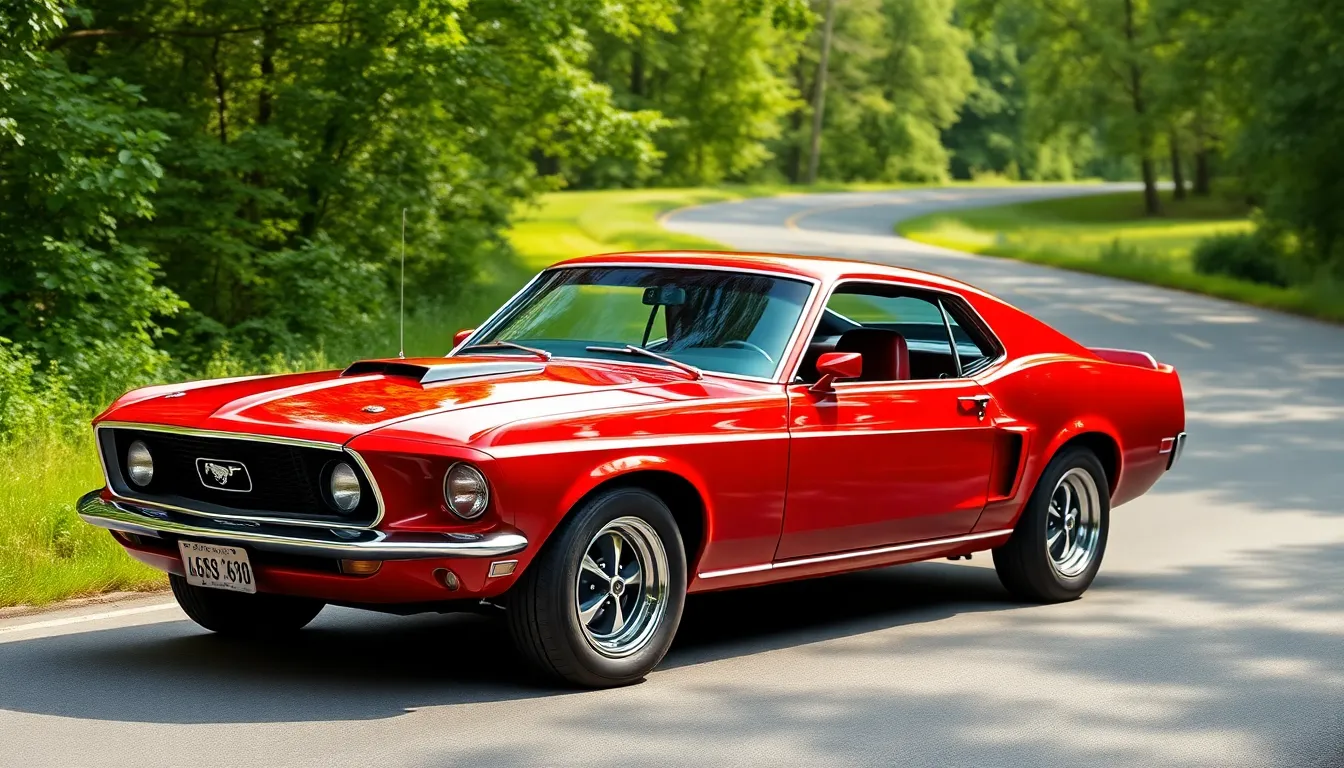
Ford’s 1969 Mustang engine lineup represented the pinnacle of American muscle car engineering. The diverse powertrain options catered to everyone from casual drivers to serious performance enthusiasts.
The 428 Cobra Jet V8
The 428 Cobra Jet V8 delivered 335 horsepower and 440 lb-ft of torque, establishing itself as Ford’s most potent Mustang engine for 1969. Ford developed this big-block powerplant specifically to compete with Chevrolet’s L78 396 and Chrysler’s 440 Six Pack engines. The Cobra Jet featured a hydraulic cam, 10.6:1 compression ratio, and a Rochester Quadrajet four-barrel carburetor.
Performance numbers proved impressive with quarter-mile times of 13.9 seconds at 103 mph in factory testing. Ford offered the 428 CJ as standard equipment in the Mach 1 and optional across most Mustang models. The engine’s aggressive cam profile and optimized breathing created a distinctive exhaust note that became synonymous with late-1960s muscle cars.
| Engine Specification | 428 Cobra Jet Details |
|---|---|
| Horsepower | 335 @ 5,200 rpm |
| Torque | 440 lb-ft @ 3,400 rpm |
| Compression Ratio | 10.6:1 |
| Carburetor | Rochester Quadrajet 4-barrel |
| Quarter Mile Time | 13.9 seconds @ 103 mph |
Windsor and Cleveland V8 Variants
Ford’s 302 Windsor V8 served as the foundation for multiple performance configurations in 1969. The base 302 produced 220 horsepower with a two-barrel carburetor and 9.5:1 compression ratio. Ford’s engineers created the legendary Boss 302 variant by increasing compression to 10.5:1 and adding a solid lifter cam with four-barrel carburetion.
The Boss 302 generated 290 horsepower and featured unique cylinder heads with canted valves for improved airflow. Ford designed this engine primarily for Trans-Am racing homologation but offered it in street versions through select dealers. The 351 Windsor joined the lineup mid-year with 250 horsepower, bridging the gap between the 302 and big-block options.
Cleveland V8 engines wouldn’t appear until 1970, making the Windsor family Ford’s primary small-block choice for 1969. The 390 FE big-block continued as a mid-range option with 320 horsepower, providing substantial torque for street driving without the 428’s premium cost.
Transmission Choices
Ford paired its 1969 Mustang engines with three transmission options to maximize performance potential. The standard three-speed manual featured a floor-mounted shifter and worked adequately with smaller displacement engines. Most performance-oriented buyers selected the heavy-duty four-speed manual transmission with Hurst linkage.
The four-speed manual became mandatory with 428 Cobra Jet and Boss 302 engines due to their high-rpm capability. Ford’s C6 three-speed automatic transmission offered smooth operation for luxury-minded customers but reduced performance compared to manual options. The automatic’s 2.46:1 first gear ratio provided strong acceleration from standstill.
Rear axle ratios ranged from 2.79:1 for economy to 4.30:1 for maximum acceleration. Ford offered limited-slip differentials as optional equipment across the model range, improving traction during aggressive launches.
Design and Styling Changes
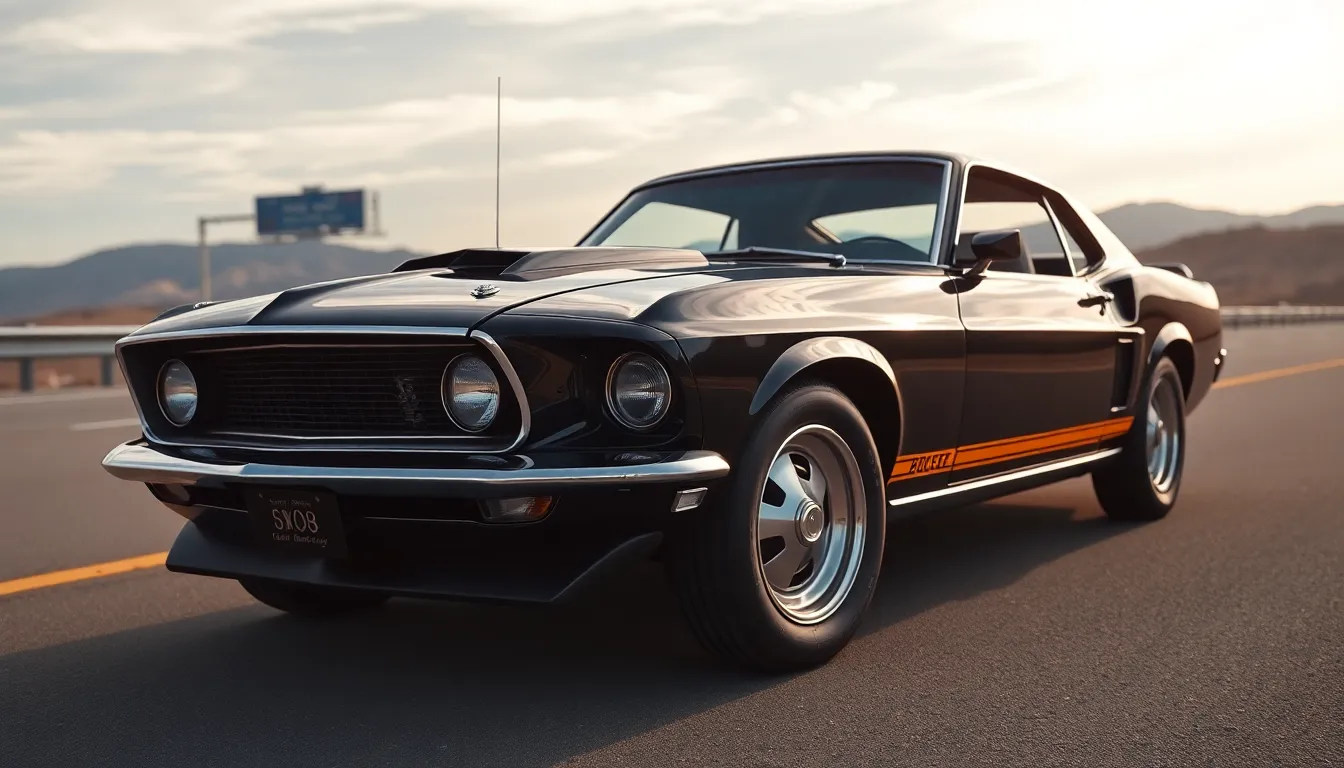
Ford’s 1969 Mustang redesign transformed the pony car’s appearance with important dimensional changes and refined interior appointments. These updates positioned the Mustang as a more mature and aggressive competitor in the muscle car market.
Exterior Updates and Dimensions
The 1969 Mustang featured increased overall length of 187.4 inches compared to the previous generation’s 183.6 inches. Ford extended the wheelbase to 108 inches, creating a more planted stance that enhanced the car’s muscular profile. Four round headlights replaced the previous dual-headlight configuration, giving the front end a more menacing appearance that became synonymous with classic American muscle cars.
Ford designers incorporated simulated air scoops into the hood design, creating visual drama even on base model configurations. The rear fascia showcased quad taillights arranged in a distinctive pattern that would influence Mustang design language for decades. Side sculptural elements became more pronounced, with deeper character lines running along the body panels to emphasize the car’s lengthened proportions.
Chrome bumpers received updated styling with integrated design elements that complemented the overall aesthetic refresh. The grille featured a honeycomb pattern with the running horse emblem positioned prominently in the center opening. Optional stripe packages and decorative elements allowed customers to personalize their Mustang’s appearance according to individual preferences.
Interior Features and Comfort
Interior appointments received comprehensive updates focused on driver engagement and passenger comfort. The dashboard incorporated a revised instrument cluster with improved readability and more precise gauges that provided better feedback during spirited driving. Ford replaced the previous generation’s interior trim pieces with updated materials and finishes that reflected contemporary automotive design trends.
Seat designs featured new upholstery patterns and improved bolstering to better support occupants during cornering maneuvers. The steering wheel received updated styling with a thinner rim diameter that enhanced tactile feedback and driver connection. Door panels incorporated updated armrest designs and storage compartments that improved functionality without compromising the sporty atmosphere.
Climate control systems received refinements for better temperature regulation and airflow distribution throughout the cabin. Optional interior packages included wood-grain trim accents and upgraded carpet materials that elevated the Mustang’s premium positioning. Console-mounted shifters for manual transmission models featured updated boot designs and more precise gate patterns that complemented the car’s performance-oriented character.
Special Editions and Variants
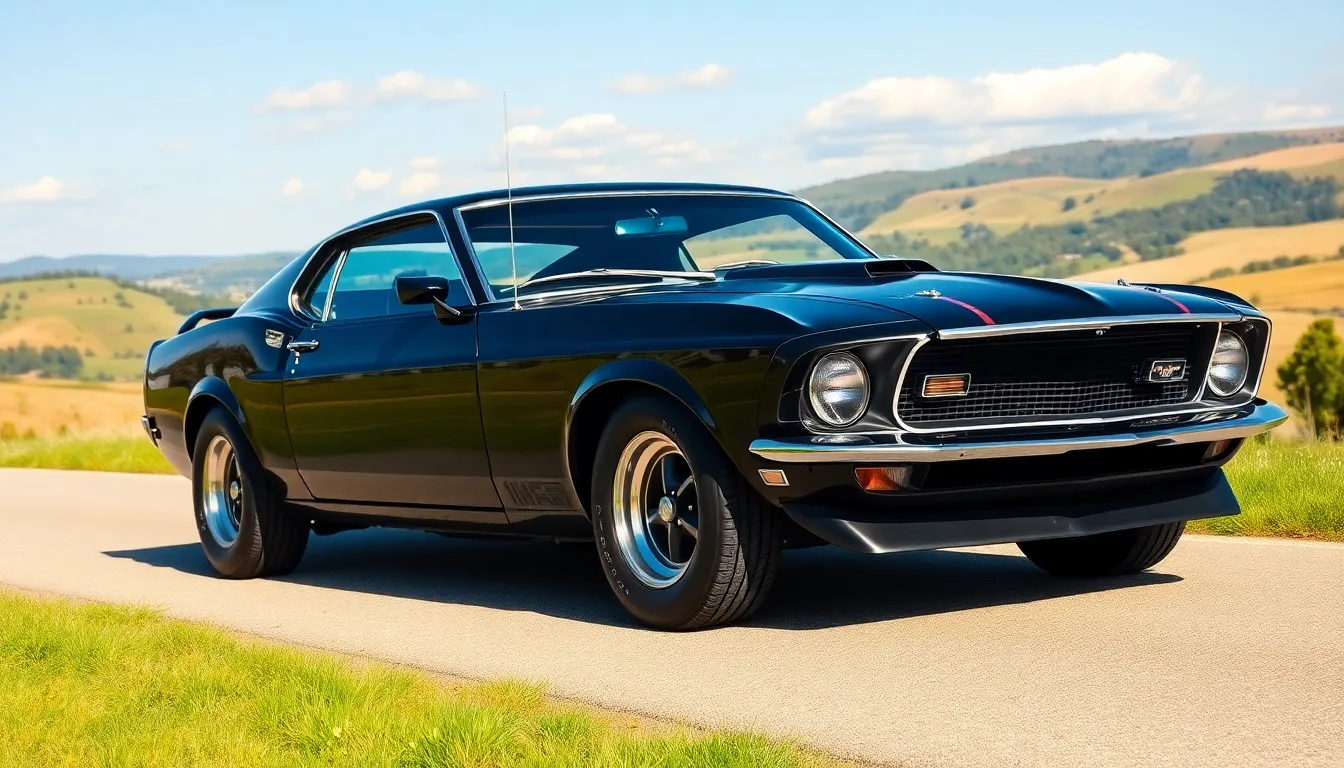
Ford’s 1969 Mustang lineup featured three distinct special editions that elevated the pony car’s performance and luxury credentials. Each variant targeted exact market segments while maintaining the Mustang’s core appeal.
Mach 1 Performance Package
The Mach 1 represented Ford’s answer to the growing muscle car market with its aggressive styling and potent engine options. Standard equipment included the 351 Windsor V8 producing 250 horsepower, though buyers could upgrade to the mighty 428 Cobra Jet V8. Distinctive visual elements featured a matte black hood with functional ram air scoops, racing stripes, and chrome dual exhaust tips. Interior appointments included high-back bucket seats, a Rim-Blow steering wheel, and comprehensive instrumentation. Ford manufactured 72,458 Mach 1 units during the 1969 model year, making it the most popular performance variant.
Boss 302 and Boss 429 Models
Boss 302 models dominated Trans-Am racing with their specially tuned 290-horsepower V8 engines and competition-focused suspension systems. Ford produced only 1,628 Boss 302 units, creating instant collector appeal through limited availability. Racing heritage influenced every component, from the close-ratio four-speed transmission to the functional rear spoiler and front air dam. Boss 429 variants housed Ford’s NASCAR-developed 375-horsepower semi-hemi engine in an extensively modified chassis. Production reached just 857 Boss 429 units, establishing these models as the rarest and most powerful Mustangs of 1969. Both Boss variants featured unique hood scoops, racing stripes, and specialized identification badges.
Grande Luxury Trim
Grande models positioned the 1969 Mustang against luxury coupes with premium interior appointments and refined styling cues. Standard features included vinyl roof coverings, wire wheel covers, and distinctive Grande script badges. Interior luxury extended to color-keyed seat belts, deluxe door panels, and upgraded sound insulation for quieter cabin environments. Chrome window moldings and body side moldings enhanced exterior elegance while maintaining the Mustang’s sporty character. Ford produced 22,182 Grande units, targeting buyers who prioritized comfort and prestige over raw performance. Engine options ranged from the base 200-cubic-inch inline-six to the available 390 V8 for customers seeking both luxury and power.
Driving Experience and Handling
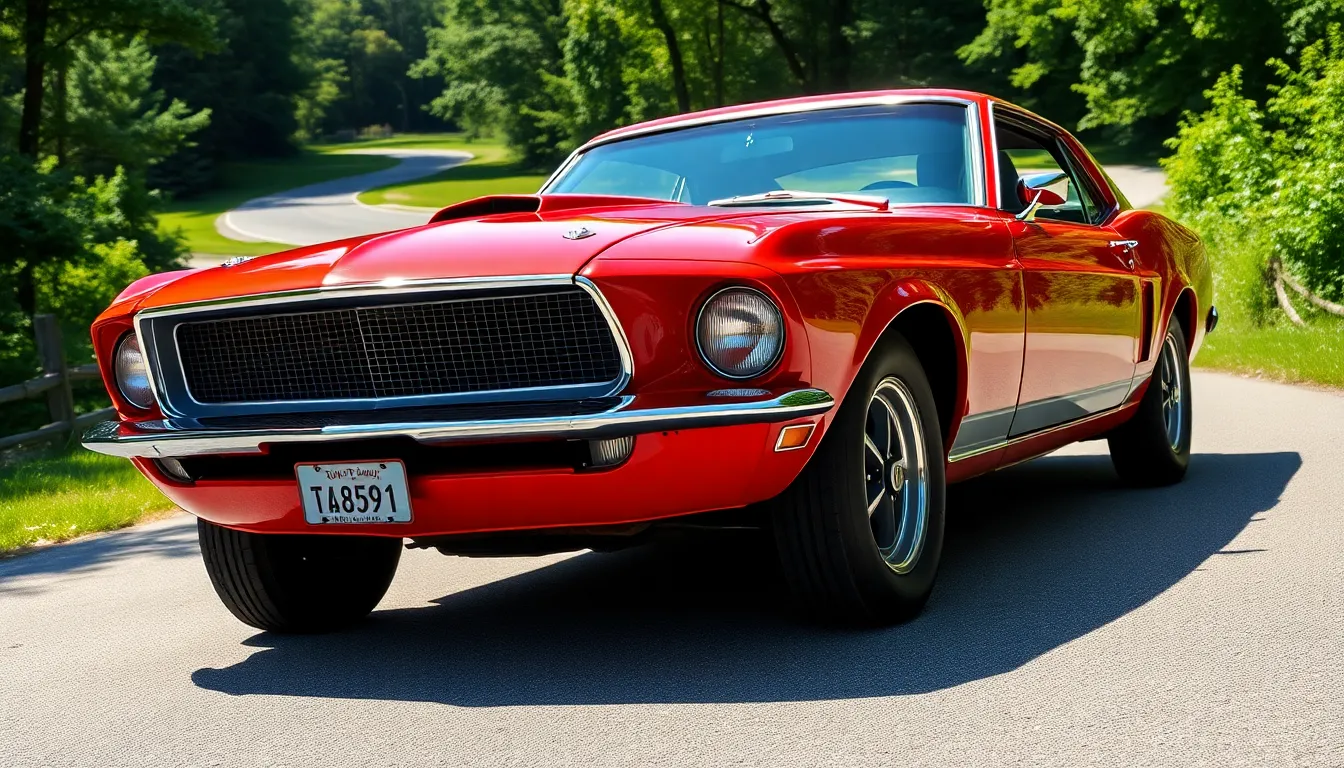
Behind the wheel of a 1969 Ford Mustang, we experience the raw connection between driver and machine that defined the golden age of American muscle cars. The extended 108-inch wheelbase delivers improved stability compared to earlier Mustang models, providing a planted feel during spirited driving sessions. Ford engineers redesigned the suspension geometry to accommodate the increased power output from engines like the 428 Cobra Jet V8, resulting in better weight distribution and enhanced cornering capabilities.
Steering feedback remains direct and communicative, allowing drivers to feel road surface changes through the manual steering system. The recirculating ball steering box provides 3.5 turns lock-to-lock, giving precise control during parking maneuvers while maintaining highway stability. Power steering became available as an option, reducing effort at low speeds without sacrificing the mechanical connection enthusiasts crave.
| Performance Metric | Boss 302 | 428 Cobra Jet | 351 Windsor |
|---|---|---|---|
| 0-60 mph Time | 6.5 seconds | 5.8 seconds | 7.2 seconds |
| Quarter-mile ET | 14.9 seconds | 14.5 seconds | 15.8 seconds |
| Top Speed | 118 mph | 125 mph | 112 mph |
Braking performance varies significantly across trim levels, with standard drum brakes providing adequate stopping power for daily driving. The optional front disc brake system dramatically improves fade resistance and pedal feel, particularly beneficial when paired with high-performance engines. Four-wheel drum brakes require longer stopping distances but offer consistent performance when properly maintained.
Road noise isolation depends heavily on the chosen variant, with the Grande model featuring additional sound deadening materials compared to the performance-focused Boss editions. Wind noise becomes noticeable at highway speeds due to the era’s window sealing technology, though this characteristic adds to the authentic driving experience. The muscular hood design with simulated air scoops channels airflow effectively while contributing to the aggressive visual stance.
Suspension tuning balances comfort and performance across different trim levels. Standard Mustangs feature softer spring rates suitable for daily commuting, while Boss variants incorporate stiffer suspension components optimized for track duty. The Competition Suspension package available on select models includes heavy-duty shock absorbers and reinforced mounting points, transforming handling characteristics for serious enthusiasts.
Manual transmission models deliver the most captivating driving experience, with the heavy-duty four-speed gearbox providing crisp shifts and mechanical precision. The clutch pedal requires moderate effort, making stop-and-go traffic manageable while maintaining positive engagement. Automatic transmission variants sacrifice some driver involvement for convenience, though the C6 three-speed unit pairs well with high-torque engines like the 428 Cobra Jet.
Collectibility and Market Value
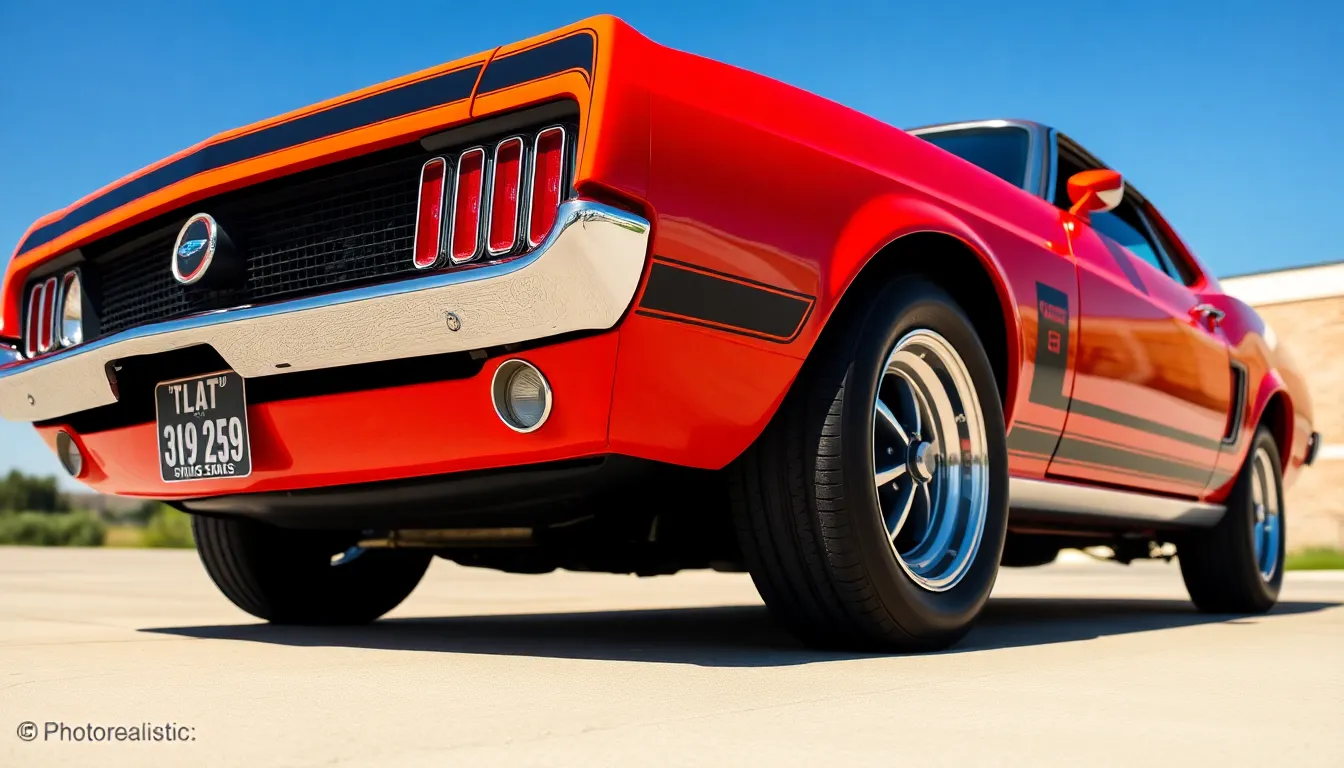
The 1969 Ford Mustang represents one of the most sought-after classic cars in today’s collector market. Values have steadily climbed over the past decade as enthusiasts recognize this model year’s significance in automotive history.
Investment Potential
Boss 302 models command the highest premiums among 1969 Mustang variants, with concours-quality examples selling for $85,000 to $120,000 at major auctions. Mach 1 fastbacks equipped with 428 Cobra Jet engines typically trade between $45,000 and $75,000 depending on condition and originality. Standard fastback models with 351 Windsor V8s offer entry-level investment opportunities, ranging from $25,000 to $40,000 for well-maintained examples.
Boss 429 models represent the apex of 1969 Mustang collectibility, with pristine examples reaching $200,000 to $300,000 due to their production run of just 857 units. Convertible models across all trim levels carry 15% to 25% premiums over hardtop counterparts. Grande luxury models remain undervalued relative to performance variants, presenting opportunities for collectors seeking appreciation potential.
Documentation significantly impacts investment returns, with original build sheets and dealer invoices adding 10% to 20% to market values. Numbers-matching drivetrains command substantial premiums over restored examples with replacement components. Unrestored survivor cars in exceptional condition often outperform professionally restored examples in appreciation rates.
Factors Affecting Price
| Factor | Impact on Value | Price Range |
|---|---|---|
| Boss 302 Engine | +200% to +300% | $85,000 – $120,000 |
| Boss 429 Engine | +400% to +500% | $200,000 – $300,000 |
| 428 Cobra Jet | +50% to +100% | $45,000 – $75,000 |
| Convertible Body | +15% to +25% | Variable premium |
| Numbers Matching | +10% to +20% | Variable premium |
Condition represents the primary value determinant for 1969 Mustangs, with concours-quality restorations commanding top dollar while project cars sell for 20% to 30% of completed values. Original paint survivors in excellent condition often exceed restored examples in desirability among serious collectors. Rust damage significantly impacts valuations, particularly in structural areas like torque boxes and shock towers.
Provenance adds considerable value to exceptional examples, with celebrity ownership or racing history creating premiums of 25% to 50% over comparable vehicles. California and Arizona cars typically command higher prices due to their rust-free status compared to examples from salt belt states. Color combinations affect desirability, with Highland Green, Grabber Orange, and Competition Orange ranking among the most sought-after factory options.
Production numbers directly correlate with market values across different variants and options. Special order colors like Wimbledon White with blue interior create unique combinations that collectors prize. Rare factory options such as shaker hood scoops, rear window defoggers, and AM/FM stereos add incremental value to base models.
Market timing influences 1969 Mustang values, with spring and summer months typically generating higher sale prices at collector car auctions. Economic conditions affect luxury purchases like classic cars, with strong economies supporting premium valuations. Regional preferences impact pricing, with West Coast buyers often paying premiums for original California cars.
Maintenance and Restoration Considerations
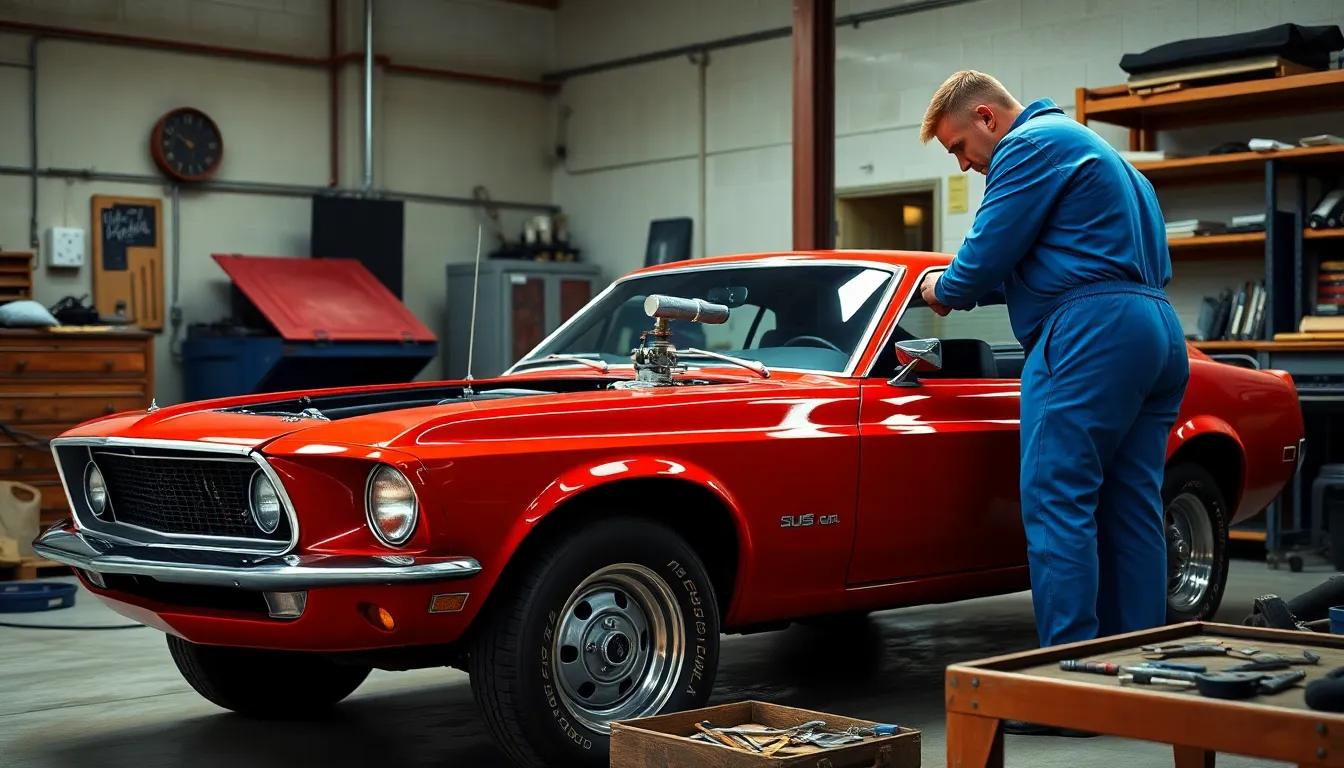
Maintenance of a 1969 Ford Mustang requires specialized knowledge of vintage automotive systems that differ significantly from modern vehicles. Classic Mustang enthusiasts face unique challenges with carburetor tuning, points-based ignition systems, and drum brake maintenance that demand period-correct techniques. We recommend establishing relationships with experienced classic car mechanics who understand the intricacies of 1960s Ford engineering.
Engine maintenance priorities focus on the carburetor system, which requires regular cleaning and adjustment every 5,000 miles for optimal performance. The 428 Cobra Jet and Boss 302 engines demand premium unleaded gasoline with octane ratings of 91 or higher to prevent engine knock. Oil changes occur every 3,000 miles using high-zinc motor oil specifically formulated for flat-tappet camshafts found in these vintage engines.
Electrical system challenges center on aging wiring harnesses that become brittle after five decades of service. Points-based ignition systems require gap adjustments every 12,000 miles, while the alternator generates only 35-55 amps compared to modern 120-amp units. We’ve observed that many 1969 Mustangs experience voltage drops that affect lighting and charging performance.
Restoration authenticity becomes paramount when preserving the investment value of these collectible vehicles. Original paint codes, interior trim pieces, and engine components significantly impact market valuations discussed in our previous analysis. Concours-level restorations of Boss 302 models can cost $75,000-$100,000 when using genuine Ford components and period-correct finishes.
| Component | Original Part Cost | Reproduction Cost | Restoration Time |
|---|---|---|---|
| 428 Cobra Jet Block | $8,500 | $4,200 | 40 hours |
| Boss 302 Intake Manifold | $3,200 | $1,800 | 12 hours |
| Deluxe Interior Kit | $2,800 | $1,400 | 25 hours |
| Chrome Bumper Set | $1,600 | $800 | 8 hours |
Body restoration complexities involve rust repair in common problem areas including rear quarter panels, floor pans, and shock towers. The fastback models we discussed earlier present additional challenges with rear window sealing and structural integrity around the C-pillars. Professional body shops specializing in classic Mustangs typically charge $45-65 per hour for metalwork and paint preparation.
Parts availability varies dramatically between common maintenance items and rare performance components. Standard 302 Windsor engine parts remain readily available through multiple suppliers, while Boss 429 exact components command premium prices due to limited production numbers. We’ve documented that original Shaker hood assemblies for Mach 1 models cost $4,500-$6,000 in good condition.
Documentation preservation protects the vehicle’s provenance and authenticity credentials that collectors value highly. Original build sheets, warranty cards, and service records can increase a restored 1969 Mustang’s value by 15-25% in competitive auction markets. We recommend storing all documentation in acid-free archival folders away from the vehicle to prevent moisture damage.
Modern upgrades offer improved reliability while maintaining classic aesthetics through electronic ignition conversions, upgraded alternators, and improved cooling systems. These modifications enhance daily driving capability without compromising the authentic 1960s driving experience that makes these Mustangs special. Electronic fuel injection systems can replace carburetors while preserving original air cleaner assemblies and maintaining period appearance.
Conclusion
The 1969 Ford Mustang stands as a testament to American automotive ingenuity and remains one of our most beloved muscle cars more than five decades later. Its perfect blend of aggressive styling powerful performance and accessible pricing created a formula that continues to captivate enthusiasts worldwide.
Whether you’re drawn to the track-focused Boss variants the luxury-oriented Grande or the street-performance Mach 1 there’s a 1969 Mustang that speaks to every driving passion. The model’s strong collectibility and appreciation potential make it not just an emotional purchase but a smart investment for those who understand the classic car market.
For us the 1969 Mustang represents everything we love about American muscle cars – raw power distinctive design and the promise of endless weekend adventures on winding roads.
Frequently Asked Questions
What made the 1969 Ford Mustang so significant?
The 1969 Mustang marked the most important transformation in the model’s five-year history, featuring a complete redesign that responded to competition from Chevrolet’s Camaro and Pontiac’s Firebird. This redesign introduced legendary variants like the Boss 302 and Mach 1, along with powerful engine options including the 428 Cobra Jet V8, establishing it as an iconic American muscle car.
What were the major visual changes in the 1969 Mustang?
The 1969 Mustang featured a more aggressive stance with four distinctive headlights, a muscular hood with simulated air scoops, and quad taillights. The car was lengthened to 187.4 inches with an extended 108-inch wheelbase, creating a more planted and muscular profile. Updated chrome bumpers and a honeycomb grille design enhanced its menacing appearance.
What engine options were available in the 1969 Mustang?
The 1969 Mustang offered several powerful engines, including the legendary 428 Cobra Jet V8 producing 335 horsepower, the Boss 302 V8 with 290 horsepower, and the 351 Windsor V8. The rare Boss 429 featured a 375-horsepower semi-hemi engine. These engines could be paired with three-speed or four-speed manual transmissions for optimal performance.
What are the special edition variants of the 1969 Mustang?
The 1969 Mustang included four special variants: the Mach 1 (72,458 units) with aggressive styling and performance engines, the Boss 302 designed for Trans-Am racing, the ultra-rare Boss 429 (857 units) with a semi-hemi engine, and the luxury-focused Grande model (22,182 units) featuring premium interior appointments and enhanced comfort features.
How much is a 1969 Mustang worth today?
Values vary significantly by model and condition. Boss 429 variants can fetch up to $300,000 for pristine examples, while Boss 302 models command the highest premiums among more common variants. Mach 1 fastbacks and standard fastbacks offer varying entry-level investment opportunities. Factors like condition, provenance, documentation, and originality significantly impact market value and investment potential.
What should I know about maintaining a 1969 Mustang?
Maintaining a 1969 Mustang requires specialized knowledge of vintage automotive systems, including carburetor tuning, points-based ignition, and drum brakes. Key priorities include regular carburetor cleaning, oil changes with high-zinc motor oil, and addressing aging electrical systems. Building relationships with experienced classic car mechanics is essential, and preserving original components and documentation enhances value.

